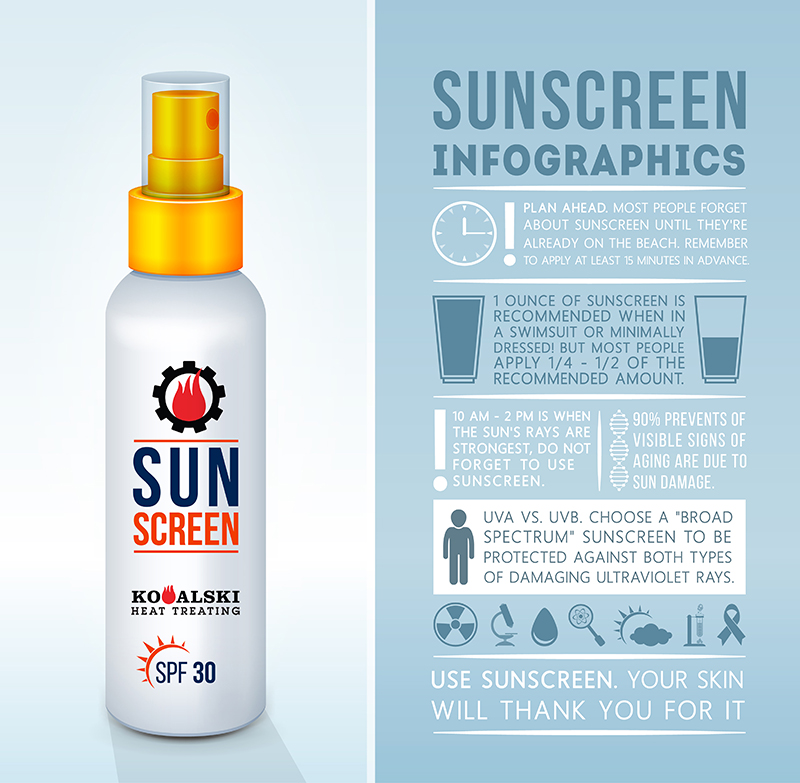That Burning Sensation

No matter what you like to do outside, gotta play it safe with sun exposure.
With this most recent batch of amazing weather, it got me thinking about sun exposure and the impact of prolonged sun on skin. Like most of us, I LOVE being outside – riding bikes, running, kayaking with Jackie and the girls, playing golf with my buds or just enjoying the summer breeze in the backyard. I’ve experienced that “burning sensation” telling me it’s time to get out of the sun or put on more protection. For those who don’t know I am what some might call follicley challenged (bald!) So…. This blog really hits home with me. As “heat people” we know a thing or two about heat, cold and temperature, when we’re solving your PIA (pain in the #$%) Jobs! I decided to do some digging on sunscreen and found this great article at livescience.com along with some tips on Wikipedia. Take a read and be sure to load up on the sunblock – and ENJOY this amazing weather.
- Whether you’re lounging on the beach, going for a run or bike ride or hiking up a mountain, when you’re outside, you’re pummeled by invisible rays that can cause your skin to darken and burn. This ultraviolet (UV) radiation can also damage DNA in your skin cells, causing genetic mutations that can lead to skin cancer. Fortunately, you can protect against many of the damaging effects of these rays with sunscreen.
- Sunscreens, which can be sprays, lotions, gels or waxes, are usually made up of a mix of chemicals. Inorganic chemicals in sunscreen can reflect or scatter the light away from the skin, and organic (carbon-based) ones can absorb UV rays so that our skin doesn’t.
- Some inorganic chemicals, including minerals such as zinc oxide or titanium dioxide, act as a physical sunblock. They reflect UV rays, similar to how white paint reflects light. The white-colored noses on beach-goers in the 1980s and 1990s were due to these compounds; because manufacturers make the inorganic particles much smaller now, we don’t see the visible white.
- Along with inorganic chemicals, sunscreens often contain organic chemicals, with names such as avobenzone or oxybenzone. Instead of physically deflecting UV light, these molecules absorb UV radiation through their chemical bonds. As the bonds absorb UV radiation, the components of the sunscreen slowly break down and release heat.
- The SPF (introduced in 1974) on sunscreen bottles stands for Sun Protection Factor (I never knew this) and refers to how well the sunscreen protects against one type of UV radiation, called UVB (it may be helpful to think B for burning). UVB rays cause sunburn and several types of skin cancer.
- To understand how the rating works – “SPF 15” means that 1⁄15 of the burning radiation will reach the skin, assuming sunscreen is applied evenly at a thick dosage of 2 milligrams per square centimeter (mg/cm2). A user can determine the effectiveness of a sunscreen by multiplying the SPF by the length of time it takes for him or her to suffer a burn without sunscreen. (Thus, if a person develops a sunburn in 10 minutes when not wearing a sunscreen, the same person in the same intensity of sunlight will take 150 minutes to develop a sunburn of the same severity if wearing a sunscreen with an SPF of 15) It is important to note that sunscreens with higher SPF do not last or remain effective on the skin any longer than lower SPF and must be continually reapplied as directed, usually every two hours.
- The SPF is an imperfect measure of skin damage because invisible damage and skin aging are also caused by ultraviolet type A (UVA, wavelengths 315–400 or 320–400 nm), which does not primarily cause reddening or pain. Conventional sunscreen blocks very little UVA radiation relative to the nominal SPF; broad-spectrum sunscreens are designed to protect against both UVB and UVA.
- Another type of radiation, called UVA radiation, penetrates deeper into the skin and can cause premature wrinkling, age spots and can also heighten the risk for some skin cancer. Sunscreen lotions labeled broad-spectrum block against both UVA and UVB, but currently there is no standard for listing UVA blocking power. Inorganic chemicals that deflect sunlight will deflect both UVA and UVB rays.
- The ultraviolet protection factor (UPF) is a similar scale developed for rating fabrics for sun protective clothing. According to recent testing by Consumer Reports, UPF ~30+ is typical for protective fabrics, while UPF ~20 is typical for standard summer fabrics.
- Most organizations recommend using sunscreen with an SPF between 15 and 50 (SPF ratings higher than 50 have not been proven to be more effective than SPF 50). A sunscreen with an SPF of 15 protects against about 93 percent of UVB rays, and one with an SPF of 30 protects against 97 percent of rays, according to the Mayo Clinic. No SPF can block 100 percent of UV rays. I am a SPF 50 man (It’s because I am such a sensitive soul!)
- Because most people don’t use enough sunscreen and because sunscreen tends to rub or wash off, the Skin Cancer Foundation recommends reapplying sunscreen within two hours regardless of its strength, and using at least an ounce (a shot glass-full) for maximum protection. My guess is that most of us do fall into the not enough category! Also, I think we should only use shot glasses as God intended!
- For people with fair skin, health organizations strongly recommend also using a hat and sunglasses, long sleeve clothing and shade to protect your skin. For those of us that ‘BRONZE” a hat should be fine!




Leave a Reply
Want to join the discussion?Feel free to contribute!